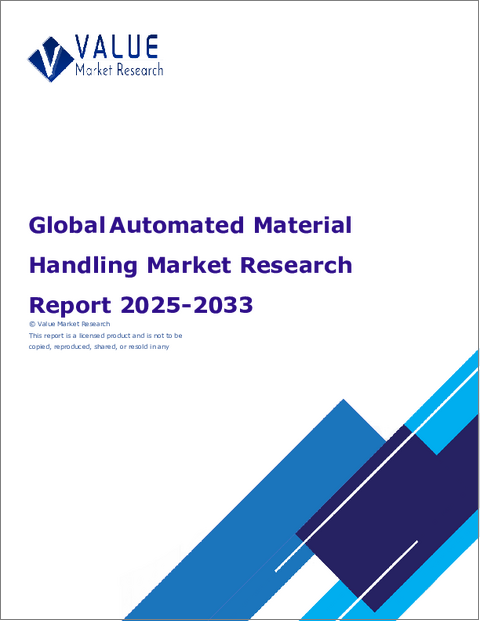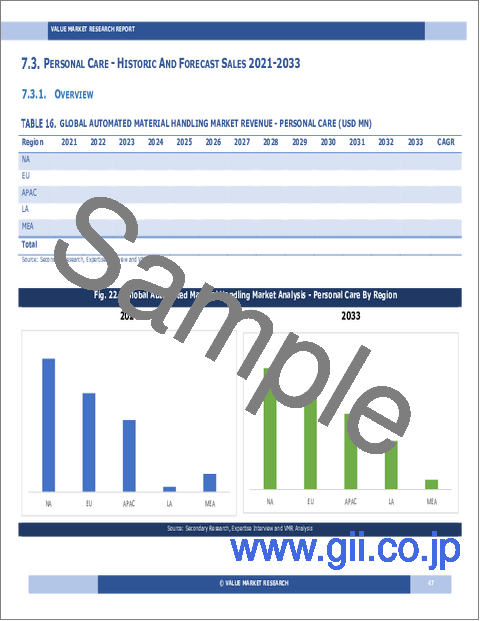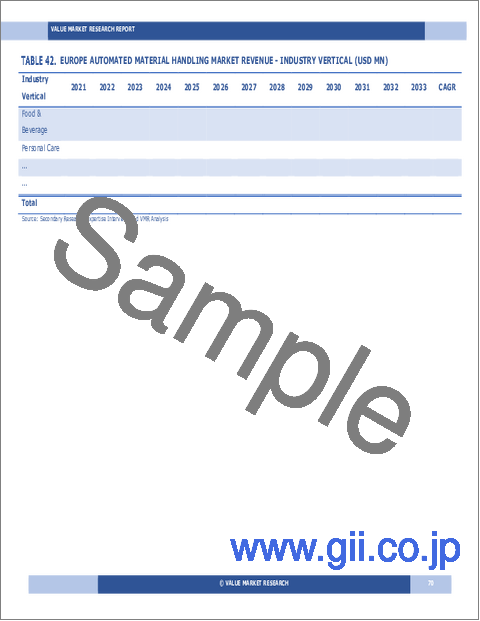|
|
市場調査レポート
商品コード
1697239
自動マテリアルハンドリングの世界市場調査レポート:産業分析、規模、シェア、成長、動向、予測(2025年~2033年)Global Automated Material Handling Market Research Report- Industry Analysis, Size, Share, Growth, Trends and Forecast 2025 to 2033 |
||||||
カスタマイズ可能
|
|||||||
| 自動マテリアルハンドリングの世界市場調査レポート:産業分析、規模、シェア、成長、動向、予測(2025年~2033年) |
|
出版日: 2025年03月01日
発行: Value Market Research
ページ情報: 英文 148 Pages
納期: 即日から翌営業日
|
全表示
- 概要
- 図表
- 目次
世界の自動マテリアルハンドリングの市場規模は、2024年の510億9,000万米ドルから2033年には1,058億5,000万米ドルに成長し、2026年~2033年の予測期間中に8.43%の堅調な年間平均成長率(CAGR)を示すと予測されます。
自動マテリアルハンドリング市場は、ロジスティクスと製造業務における効率性と生産性に対する需要の高まりに牽引され、大幅な成長を遂げようとしています。コンベア、ロボットアーム、無人搬送車(AGV)を含む自動マテリアルハンドリングシステムは、サプライチェーンプロセスの最適化と人件費の削減に不可欠なものとなっています。産業界が消費者の期待の高まりと納期短縮の必要性に直面する中、自動化ソリューションの採用が急増すると予想されます。この動向は、企業が業務効率の向上とマテリアルハンドリングプロセスの合理化を目指す中で、市場の成長を促進すると予想されます。
さらに、自動化技術の進歩は、マテリアルハンドリングシステムの性能と能力を継続的に向上させています。人工知能、機械学習、高度なセンサーなどの革新は、変化する業務上の要求に適応できる、よりスマートで柔軟なソリューションの開発を可能にしています。IoTとリアルタイムデータ分析の統合は、自動マテリアルハンドリングシステムの効率性と信頼性をさらに高めています。企業がオペレーショナル・エクセレンスとコスト削減をますます優先するようになるにつれ、高度な自動化ソリューションへの需要が高まり、市場は今後数年間持続的に成長すると予想されます。
加えて、eコマースの世界的な拡大とサプライチェーンの最適化への注目の高まりは、自動マテリアルハンドリング市場に有利な機会を生み出すと予想されます。企業が消費者の需要の高まりに対応するため、物流・倉庫業務の近代化に投資する中、効果的な自動マテリアルハンドリングソリューションの必要性はさらに高まると思われます。自動マテリアルハンドリング市場の将来は、自動化技術の強化と用途の拡大を目指した継続的な研究開発努力によって形作られます。利害関係者は、マテリアルハンドリング業務の効率性と生産性の絶え間ない追求によって促進される、革新と成長を特徴とするダイナミックな環境を予測することができます。
当社のレポートは、様々な産業や市場に関する包括的かつ実用的な洞察をお客様に提供できるよう、綿密に作成されています。各レポートは、市場情勢を完全に理解するために、いくつかの重要な要素を含んでいます:
市場概要:定義、分類、業界の現状に関する概要など、市場に関する詳細なイントロダクションです。
市場力学:市場成長に影響を与える主な促進要因・抑制要因・機会・課題を詳細に分析します。このセクションでは、技術の進歩、規制の変更、新たな動向などの要因を検証します。
セグメンテーション分析:製品タイプ、用途、エンドユーザー、地域などの基準に基づき、市場を明確なセグメントに分けています。この分析により、各セグメントの業績と将来性を明らかにします。
競合情勢:市場シェア、製品ポートフォリオ、戦略的イニシアティブ、財務実績など、主要市場企業を包括的に評価しています。主要企業が採用する競合力学と主要戦略に関する考察を提供します。
市場予測:実績データと現在の市場状況に基づき、一定期間における市場規模と成長動向を予測しています。これには、定量的分析と将来の市場軌跡を示すグラフ表示が含まれます。
地域分析:地域ごとの市場パフォーマンスを評価し、主要市場や地域動向を明らかにします。地域の市場力学とビジネスチャンスを理解するのに役立ちます。
新たな動向と機会:現在の市場動向と新たな市場動向、技術革新、潜在的な投資対象分野を特定します。将来の市場開拓と成長見通しに関する洞察を提供します。
目次
第1章 序文
第2章 エグゼクティブサマリー
- 市場のハイライト
- 世界市場スナップショット
第3章 自動マテリアルハンドリング業界の分析
- イントロダクション:市場力学
- 市場促進要因
- 市場抑制要因
- 機会
- 業界動向
- ポーターのファイブフォース分析
- 市場の魅力分析
第4章 バリューチェーン分析
- バリューチェーン分析
- 原材料分析
- 原材料リスト
- 原材料メーカーリスト
- 主要原材料の価格動向
- 潜在的バイヤーリスト
- マーケティングチャネル
- ダイレクトマーケティング
- インダイレクトマーケティング
- マーケティングチャネル発展動向
第5章 自動マテリアルハンドリングの世界市場分析:提供別
- 提供別の概要
- 提供別の実績・予測データ分析
- ハードウェア
- ソフトウェア
- サービス
第6章 自動マテリアルハンドリングの世界市場分析:包装タイプ別
- 包装タイプ別<の概要
- 包装タイプ別<の実績・予測データ分析
- パレット
- コンテナ
- カートン
- その他(ダンネージ、ユーティライザーなど)
第7章 自動マテリアルハンドリングの世界市場分析:業界別
- 業界別の概要
- 業界別の実績・予測データ分析
- 飲食品
- パーソナルケア
- 非耐久財
- 耐久財
- アパレル
- 医薬品
- 自動車
- 小売
- 3pL
- クーリエ、エクスプレス、小包サービス
- その他(空港サービス、ヘルスケアなど)
第8章 自動マテリアルハンドリングの世界市場分析:地域別
- 地域別展望
- イントロダクション
- 北米の売上分析
- 概要・実績・予測
- 北米:セグメント別
- 北米:国別
- 米国
- カナダ
- メキシコ
- 欧州の売上分析
- 概要・実績・予測
- 欧州:セグメント別
- 欧州:国別
- 英国
- フランス
- ドイツ
- イタリア
- ロシア
- その他欧州
- アジア太平洋の売上分析
- 概要・実績・予測
- アジア太平洋:セグメント別
- アジア太平洋:国別
- 中国
- インド
- 日本
- 韓国
- オーストラリア
- 東南アジア
- その他アジア太平洋
- ラテンアメリカの売上分析
- 概要・実績・予測
- ラテンアメリカ:セグメント別
- ラテンアメリカ:国別
- ブラジル
- アルゼンチン
- ペルー
- チリ
- その他ラテンアメリカ
- 中東・アフリカの売上分析
- 概要・実績・予測
- 中東・アフリカ:セグメント別
- 中東・アフリカ:国別
- サウジアラビア
- アラブ首長国連邦
- イスラエル
- 南アフリカ
- その他中東・アフリカ
第9章 自動マテリアルハンドリング企業の競合情勢
- 自動マテリアルハンドリング市場の競合
- 提携・協業・協定
- 合併と買収
- 新製品発売
- その他の開発
第10章 企業プロファイル
- 上位企業の市場シェア分析
- 市場集中度
- Daifuku Co. Ltd.
- Dematic
- Honeywell Intelligrated
- Vanderlande
- KNAPP AG
- Murata Machinery Ltd.
- SSI Schaefer Group
- Interlake Mecalux(MECALUX)
- WITRON Integrated Logistics
- Beumer Group GmbH
- Stow Group
- TGW Logistics Group GmbH
- SWISSLOG AG
- Bastian Solutions
- Fives Intralogistics
LIST OF TABLES
- Market Snapshot
- Drivers: Impact Analysis
- Restraints: Impact Analysis
- List of Raw Material
- List of Raw Material Manufactures
- Analysis By Offering (USD MN)
- Hardware Market Sales By Geography (USD MN)
- Software Market Sales By Geography (USD MN)
- Services Market Sales By Geography (USD MN)
- Analysis By Package Type (USD MN)
- Pallet Market Sales By Geography (USD MN)
- Containers Market Sales By Geography (USD MN)
- Cartons Market Sales By Geography (USD MN)
- Others (Dunnage, Utilizer, etc) Market Sales By Geography (USD MN)
- Analysis By Industry Vertical (USD MN)
- Food & Beverage Market Sales By Geography (USD MN)
- Personal Care Market Sales By Geography (USD MN)
- Non-durable Goods Market Sales By Geography (USD MN)
- Durable Good Market Sales By Geography (USD MN)
- Apparel Market Sales By Geography (USD MN)
- Pharmaceutical Market Sales By Geography (USD MN)
- Automotive Market Sales By Geography (USD MN)
- Retail Market Sales By Geography (USD MN)
- 3pL Market Sales By Geography (USD MN)
- Courier, Express and Parcel Services Market Sales By Geography (USD MN)
- Others (Airport Services, Healthcare, etc) Market Sales By Geography (USD MN)
- Global Automated Material Handling Market Sales By Geography (USD MN)
- North America Market Analysis (USD MN)
- United States Market Analysis (USD MN)
- Canada Market Analysis (USD MN)
- Mexico Market Analysis (USD MN)
- Europe Market Analysis (USD MN)
- Europe Market Estimate By Country (USD MN)
- United Kingdom Market Analysis (USD MN)
- France Market Analysis (USD MN)
- Germany Market Analysis (USD MN)
- Italy Market Analysis (USD MN)
- Russia Market Analysis (USD MN)
- Spain Market Analysis (USD MN)
- Rest of Europe Market Analysis (USD MN)
- Asia Pacific Market Analysis (USD MN)
- China Market Analysis (USD MN)
- Japan Market Analysis (USD MN)
- India Market Analysis (USD MN)
- South Korea Market Analysis (USD MN)
- Australia Market Analysis (USD MN)
- South East Asia Market Analysis (USD MN)
- Rest of Asia Pacific Market Analysis (USD MN)
- Latin America Market Analysis (USD MN)
- Brazil Market Analysis (USD MN)
- Argentina Market Analysis (USD MN)
- Peru Market Analysis (USD MN)
- Chile Market Analysis (USD MN)
- Rest of Latin America Market Analysis (USD MN)
- Middle East & Africa Market Analysis (USD MN)
- Saudi Arabia Market Analysis (USD MN)
- UAE Market Analysis (USD MN)
- Israel Market Analysis (USD MN)
- South Africa Market Analysis (USD MN)
- Rest of Middle East and Africa Market Analysis (USD MN)
- Partnership/Collaboration/Agreement
- Mergers And Acquisition
LIST OF FIGURES
- Research Scope of Automated Material Handling Report
- Market Research Process
- Market Research Methodology
- Global Automated Material Handling Market Size, By Region (USD MN)
- Porters Five Forces Analysis
- Market Attractiveness Analysis By Offering
- Market Attractiveness Analysis By Package Type
- Market Attractiveness Analysis By Industry Vertical
- Market Attractiveness Analysis By Region
- Value Chain Analysis
- Global Market Analysis By Offering (USD MN)
- Hardware Market Sales By Geography (USD MN)
- Software Market Sales By Geography (USD MN)
- Services Market Sales By Geography (USD MN)
- Global Market Analysis By Package Type (USD MN)
- Pallet Market Sales By Geography (USD MN)
- Containers Market Sales By Geography (USD MN)
- Cartons Market Sales By Geography (USD MN)
- Others (Dunnage, Utilizer, etc) Market Sales By Geography (USD MN)
- Global Market Analysis By Industry Vertical (USD MN)
- Food & Beverage Market Sales By Geography (USD MN)
- Personal Care Market Sales By Geography (USD MN)
- Non-durable Goods Market Sales By Geography (USD MN)
- Durable Good Market Sales By Geography (USD MN)
- Apparel Market Sales By Geography (USD MN)
- Pharmaceutical Market Sales By Geography (USD MN)
- Automotive Market Sales By Geography (USD MN)
- Retail Market Sales By Geography (USD MN)
- 3pL Market Sales By Geography (USD MN)
- Courier, Express and Parcel Services Market Sales By Geography (USD MN)
- Others (Airport Services, Healthcare, etc) Market Sales By Geography (USD MN)
- Global Market Sales (USD MN)
- North America Market Sales (USD MN)
- Europe Market Sales (USD MN)
- Asia Pacific Market Sales (USD MN)
- Latin America Market Sales (USD MN)
- Middle East & Africa Market Sales (USD MN)
- Recent Development in Industry
- Top Company Market Share Analysis
Kindly note that the above listed are the basic tables and figures of the report and are not limited to the TOC.
Global Automated Material Handling Market size is anticipated to grow from USD 51.09 Billion in 2024 to USD 105.85 Billion by 2033, showcasing a robust Compound Annual Growth Rate (CAGR) of 8.43% during the forecast period of 2026 to 2033.
The automated material handling market is set for substantial growth, driven by the increasing demand for efficiency and productivity in logistics and manufacturing operations. Automated material handling systems, including conveyors, robotic arms, and automated guided vehicles (AGVs), are becoming essential for optimizing supply chain processes and reducing labor costs. As industries face rising consumer expectations and the need for faster delivery times, the adoption of automated solutions is expected to surge. This trend is anticipated to propel the market's growth as companies seek to enhance their operational efficiency and streamline their material handling processes.
Moreover, advancements in automation technology are continuously improving the performance and capabilities of material handling systems. Innovations such as artificial intelligence, machine learning, and advanced sensors are enabling the development of smarter and more flexible solutions that can adapt to changing operational demands. The integration of IoT and real-time data analytics is further enhancing the efficiency and reliability of automated material handling systems. As companies increasingly prioritize operational excellence and cost reduction, the demand for advanced automated solutions is expected to rise, positioning the market for sustained growth in the coming years.
In addition, the global expansion of e-commerce and the increasing focus on supply chain optimization are expected to create lucrative opportunities within the automated material handling market. As companies invest in modernizing their logistics and warehousing operations to meet rising consumer demands, the need for effective automated material handling solutions will become even more critical. The future of the automated material handling market will be shaped by ongoing research and development efforts aimed at enhancing automation technologies and expanding their applications. Stakeholders can anticipate a dynamic environment characterized by innovation and growth, driven by the relentless pursuit of efficiency and productivity in material handling operations.
Our reports are meticulously crafted to provide clients with comprehensive and actionable insights into various industries and markets. Each report encompasses several critical components to ensure a thorough understanding of the market landscape:
Market Overview: A detailed introduction to the market, including definitions, classifications, and an overview of the industry's current state.
Market Dynamics: In-depth analysis of key drivers, restraints, opportunities, and challenges influencing market growth. This section examines factors such as technological advancements, regulatory changes, and emerging trends.
Segmentation Analysis: Breakdown of the market into distinct segments based on criteria like product type, application, end-user, and geography. This analysis highlights the performance and potential of each segment.
Competitive Landscape: Comprehensive assessment of major market players, including their market share, product portfolio, strategic initiatives, and financial performance. This section provides insights into the competitive dynamics and key strategies adopted by leading companies.
Market Forecast: Projections of market size and growth trends over a specified period, based on historical data and current market conditions. This includes quantitative analyses and graphical representations to illustrate future market trajectories.
Regional Analysis: Evaluation of market performance across different geographical regions, identifying key markets and regional trends. This helps in understanding regional market dynamics and opportunities.
Emerging Trends and Opportunities: Identification of current and emerging market trends, technological innovations, and potential areas for investment. This section offers insights into future market developments and growth prospects.
SEGMENTATION COVERED IN THE REPORT
By Offering
- Hardware
- Software
- Services
By Package Type
- Pallet
- Containers
- Cartons
- Others (Dunnage, Utilizer, etc)
By Industry Vertical
- Food & Beverage
- Personal Care
- Non-durable Goods
- Durable Good
- Apparel
- Pharmaceutical
- Automotive
- Retail
- 3pL
- Courier, Express and Parcel Services
- Others (Airport Services, Healthcare, etc)
- COMPANIES PROFILED
- Daifuku Co. Ltd.
- Dematic
- Honeywell Intelligrated
- Vanderlande
- KNAPP AG
- Murata Machinery Ltd.
- SSI Schaefer Group
- Interlake Mecalux (MECALUX)
- WITRON Integrated Logistics
- Beumer Group GmbH
- stow Group
- TGW Logistics Group GmbH
- SWISSLOG AG
- Bastian Solutions
- Fives Intralogistics
- The above list can be customized.
TABLE OF CONTENTS
1. PREFACE
- 1.1. Report Description
- 1.1.1 Objective
- 1.1.2 Target Audience
- 1.1.3 Unique Selling Proposition (USP) & offerings
- 1.2. Research Scope
- 1.3. Research Methodology
- 1.3.1 Market Research Process
- 1.3.2 Market Research Methodology
2. EXECUTIVE SUMMARY
- 2.1. Highlights of Market
- 2.2. Global Market Snapshot
3. AUTOMATED MATERIAL HANDLING INDUSTRY ANALYSIS
- 3.1. Introduction - Market Dynamics
- 3.2. Market Drivers
- 3.3. Market Restraints
- 3.4. Opportunities
- 3.5. Industry Trends
- 3.6. Porter's Five Force Analysis
- 3.7. Market Attractiveness Analysis
- 3.7.1 Market Attractiveness Analysis By Offering
- 3.7.2 Market Attractiveness Analysis By Package Type
- 3.7.3 Market Attractiveness Analysis By Industry Vertical
- 3.7.4 Market Attractiveness Analysis By Region
4. VALUE CHAIN ANALYSIS
- 4.1. Value Chain Analysis
- 4.2. Raw Material Analysis
- 4.2.1 List of Raw Materials
- 4.2.2 Raw Material Manufactures List
- 4.2.3 Price Trend of Key Raw Materials
- 4.3. List of Potential Buyers
- 4.4. Marketing Channel
- 4.4.1 Direct Marketing
- 4.4.2 Indirect Marketing
- 4.4.3 Marketing Channel Development Trend
5. GLOBAL AUTOMATED MATERIAL HANDLING MARKET ANALYSIS BY OFFERING
- 5.1. Overview By Offering
- 5.2. Historical and Forecast Data Analysis By Offering
- 5.3. Hardware Historic and Forecast Sales By Regions
- 5.4. Software Historic and Forecast Sales By Regions
- 5.5. Services Historic and Forecast Sales By Regions
6. GLOBAL AUTOMATED MATERIAL HANDLING MARKET ANALYSIS BY PACKAGE TYPE
- 6.1. Overview By Package Type
- 6.2. Historical and Forecast Data Analysis By Package Type
- 6.3. Pallet Historic and Forecast Sales By Regions
- 6.4. Containers Historic and Forecast Sales By Regions
- 6.5. Cartons Historic and Forecast Sales By Regions
- 6.6. Others (Dunnage, Utilizer, etc) Historic and Forecast Sales By Regions
7. GLOBAL AUTOMATED MATERIAL HANDLING MARKET ANALYSIS BY INDUSTRY VERTICAL
- 7.1. Overview By Industry Vertical
- 7.2. Historical and Forecast Data Analysis By Industry Vertical
- 7.3. Food & Beverage Historic and Forecast Sales By Regions
- 7.4. Personal Care Historic and Forecast Sales By Regions
- 7.5. Non-durable Goods Historic and Forecast Sales By Regions
- 7.6. Durable Good Historic and Forecast Sales By Regions
- 7.7. Apparel Historic and Forecast Sales By Regions
- 7.8. Pharmaceutical Historic and Forecast Sales By Regions
- 7.9. Automotive Historic and Forecast Sales By Regions
- 7.10. Retail Historic and Forecast Sales By Regions
- 7.11. 3pL Historic and Forecast Sales By Regions
- 7.12. Courier, Express and Parcel Services Historic and Forecast Sales By Regions
- 7.13. Others (Airport Services, Healthcare, etc) Historic and Forecast Sales By Regions
8. GLOBAL AUTOMATED MATERIAL HANDLING MARKET ANALYSIS BY GEOGRAPHY
- 8.1. Regional Outlook
- 8.2. Introduction
- 8.3. North America Sales Analysis
- 8.3.1 Overview, Historic and Forecast Data Sales Analysis
- 8.3.2 North America By Segment Sales Analysis
- 8.3.3 North America By Country Sales Analysis
- 8.3.4 United States Sales Analysis
- 8.3.5 Canada Sales Analysis
- 8.3.6 Mexico Sales Analysis
- 8.4. Europe Sales Analysis
- 8.4.1 Overview, Historic and Forecast Data Sales Analysis
- 8.4.2 Europe By Segment Sales Analysis
- 8.4.3 Europe By Country Sales Analysis
- 8.4.4 United Kingdom Sales Analysis
- 8.4.5 France Sales Analysis
- 8.4.6 Germany Sales Analysis
- 8.4.7 Italy Sales Analysis
- 8.4.8 Russia Sales Analysis
- 8.4.9 Rest Of Europe Sales Analysis
- 8.5. Asia Pacific Sales Analysis
- 8.5.1 Overview, Historic and Forecast Data Sales Analysis
- 8.5.2 Asia Pacific By Segment Sales Analysis
- 8.5.3 Asia Pacific By Country Sales Analysis
- 8.5.4 China Sales Analysis
- 8.5.5 India Sales Analysis
- 8.5.6 Japan Sales Analysis
- 8.5.7 South Korea Sales Analysis
- 8.5.8 Australia Sales Analysis
- 8.5.9 South East Asia Sales Analysis
- 8.5.10 Rest Of Asia Pacific Sales Analysis
- 8.6. Latin America Sales Analysis
- 8.6.1 Overview, Historic and Forecast Data Sales Analysis
- 8.6.2 Latin America By Segment Sales Analysis
- 8.6.3 Latin America By Country Sales Analysis
- 8.6.4 Brazil Sales Analysis
- 8.6.5 Argentina Sales Analysis
- 8.6.6 Peru Sales Analysis
- 8.6.7 Chile Sales Analysis
- 8.6.8 Rest of Latin America Sales Analysis
- 8.7. Middle East & Africa Sales Analysis
- 8.7.1 Overview, Historic and Forecast Data Sales Analysis
- 8.7.2 Middle East & Africa By Segment Sales Analysis
- 8.7.3 Middle East & Africa By Country Sales Analysis
- 8.7.4 Saudi Arabia Sales Analysis
- 8.7.5 UAE Sales Analysis
- 8.7.6 Israel Sales Analysis
- 8.7.7 South Africa Sales Analysis
- 8.7.8 Rest Of Middle East And Africa Sales Analysis
9. COMPETITIVE LANDSCAPE OF THE AUTOMATED MATERIAL HANDLING COMPANIES
- 9.1. Automated Material Handling Market Competition
- 9.2. Partnership/Collaboration/Agreement
- 9.3. Merger And Acquisitions
- 9.4. New Product Launch
- 9.5. Other Developments
10. COMPANY PROFILES OF AUTOMATED MATERIAL HANDLING INDUSTRY
- 10.1. Top Companies Market Share Analysis
- 10.2. Market Concentration Rate
- 10.3. Daifuku Co. Ltd.
- 10.3.1 Company Overview
- 10.3.2 Company Revenue
- 10.3.3 Products
- 10.3.4 Recent Developments
- 10.4. Dematic
- 10.4.1 Company Overview
- 10.4.2 Company Revenue
- 10.4.3 Products
- 10.4.4 Recent Developments
- 10.5. Honeywell Intelligrated
- 10.5.1 Company Overview
- 10.5.2 Company Revenue
- 10.5.3 Products
- 10.5.4 Recent Developments
- 10.6. Vanderlande
- 10.6.1 Company Overview
- 10.6.2 Company Revenue
- 10.6.3 Products
- 10.6.4 Recent Developments
- 10.7. KNAPP AG
- 10.7.1 Company Overview
- 10.7.2 Company Revenue
- 10.7.3 Products
- 10.7.4 Recent Developments
- 10.8. Murata Machinery Ltd.
- 10.8.1 Company Overview
- 10.8.2 Company Revenue
- 10.8.3 Products
- 10.8.4 Recent Developments
- 10.9. SSI Schaefer Group
- 10.9.1 Company Overview
- 10.9.2 Company Revenue
- 10.9.3 Products
- 10.9.4 Recent Developments
- 10.10. Interlake Mecalux (MECALUX)
- 10.10.1 Company Overview
- 10.10.2 Company Revenue
- 10.10.3 Products
- 10.10.4 Recent Developments
- 10.11. WITRON Integrated Logistics
- 10.11.1 Company Overview
- 10.11.2 Company Revenue
- 10.11.3 Products
- 10.11.4 Recent Developments
- 10.12. Beumer Group GmbH
- 10.12.1 Company Overview
- 10.12.2 Company Revenue
- 10.12.3 Products
- 10.12.4 Recent Developments
- 10.13. Stow Group
- 10.13.1 Company Overview
- 10.13.2 Company Revenue
- 10.13.3 Products
- 10.13.4 Recent Developments
- 10.14. TGW Logistics Group GmbH
- 10.14.1 Company Overview
- 10.14.2 Company Revenue
- 10.14.3 Products
- 10.14.4 Recent Developments
- 10.15. SWISSLOG AG
- 10.15.1 Company Overview
- 10.15.2 Company Revenue
- 10.15.3 Products
- 10.15.4 Recent Developments
- 10.16. Bastian Solutions
- 10.16.1 Company Overview
- 10.16.2 Company Revenue
- 10.16.3 Products
- 10.16.4 Recent Developments
- 10.17. Fives Intralogistics
- 10.17.1 Company Overview
- 10.17.2 Company Revenue
- 10.17.3 Products
- 10.17.4 Recent Developments






